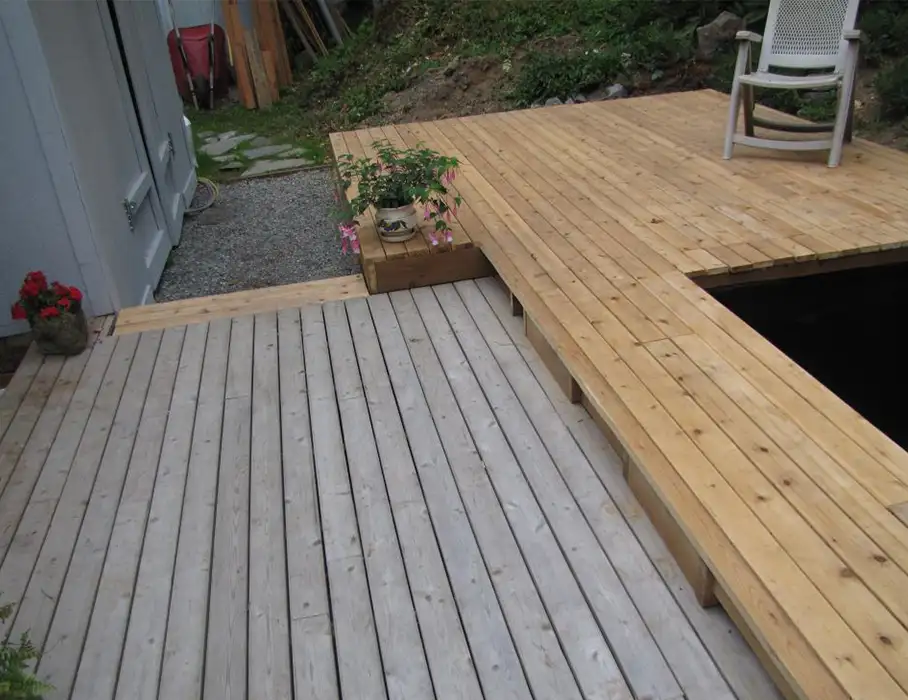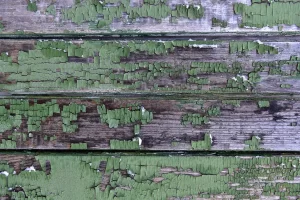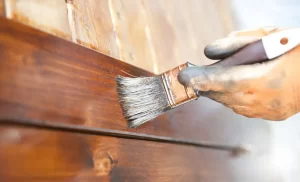Decks are a great addition to any home; they provide additional space for entertaining and relaxing and can even increase the value of your home. But like any exterior surface, decks require regular maintenance to look their best. One of the most common problems that homeowners face is peeling paint.
While peeling paint may seem like a cosmetic issue, it can lead to more serious problems if not addressed. Peeling paint is often a sign of underlying water damage, which can rot the wood and lead to expensive repairs. But with a little elbow grease, you can easily repaint your deck and make it look good as new!
Here’s what you need to know everything about your decks. :
What Causes Peeling Paint on Decks?
Before you can learn how to paint a deck with peeling paint, it’s important to understand what causes this problem in the first place. There are a few different reasons why paint may start to peel off of a deck:
1. Water Damage:
One of the most common reasons for peeling paint is water damage. If your deck isn’t properly sealed or if it isn’t made of rot-resistant wood, moisture can seep in and cause the paint to peel. Washing your deck with a power washer can also cause paint to peel if you’re not careful.
Generally, you’ll be able to tell if water damage is the cause of your peeling paint because the wood will feel spongy or soft to the touch. There may also be signs of mold or mildew.
2. Sun Damage:
Prolonged exposure to sunlight can also cause paint to peel. The UV rays from the sun break down the paint’s molecules, causing it to become brittle and flake off. This is especially common with darker colors of paint, which absorb more heat from the sun.
You may be able to tell if sun damage is the cause of your peeling paint because the affected areas will look faded or discolored.
3. Improper Painting Techniques:
If you don’t prepare the surface properly before painting or if you use low-quality paint, it’s more likely that the paint will start to peel. Using the right type of paint for your deck is also important. Oil-based paints are not recommended for decks because they don’t stand up well to foot traffic and weathering.
In most cases, you’ll be able to tell if improper painting techniques cause your peeling paint because the paint will start to peel soon after it’s applied.
4. Excessive Heat:
Applying paint to a deck that’s too hot can also cause peeling. If the surface is more than 50 degrees Fahrenheit, the paint won’t adhere properly and is more likely to peel.
You’ll know if excessive heat is the cause of your peeling paint because the affected areas will look wrinkled or bubbled.
Best Method to Paint a Deck With Peeling Paint
Here are a few different methods that you can use to paint a deck with peeling paint:
Power Washing your Deck:
If the paint is peeling because of dirt or grime build-up, power washing can effectively remove it. Be careful not to use too much pressure, as this can damage the wood. You should also avoid using a power washer if the paint is peeling because of water damage, as this will only worsen the problem.
Power washer and pressure washer are two terms that are often used interchangeably, but they refer to two pieces of equipment. A power washer is a machine that uses high-pressure water to clean surfaces. A pressure washer is a type of power washer that also uses detergent to break down tough stains.
When using a power washer, always start with the lowest setting and gradually increase the pressure until you find one effective at removing the paint without damaging the wood.
Sanding your Deck:
If the paint is peeling because of sun or water damage, sanding can help remove it. Start by using coarse-grit sandpaper to remove the majority of the paint. Then, switch to finer-grit sandpaper to smooth out the surface.
Be sure to sand in the grain direction to avoid damaging the wood. You should also vacuum up any dust created while sanding to avoid breathing it in.
Priming your Deck:
If the paint is peeling because of improper painting techniques, priming can help to ensure that the new paint will adhere properly. Start by removing any loose paint with a putty knife. Then, apply a primer designed for use on exterior surfaces.
Let the primer dry completely before painting. Be sure to read the manufacturer’s instructions to determine how long it will take for the primer to dry.
Stripping your Deck:
Start by applying a paint stripper to the affected areas. If the paint is peeling because of poor-quality paint, stripping can effectively remove it. Let it sit for the amount of time specified by the manufacturer.
Then, use a putty knife or paint scraper to remove the stripper and any remaining paint. Be sure to wear gloves and eye protection while doing this.
Repainting your Deck:
Start by cleaning the surface with a deck cleaner or a garden hose. Then, apply primer and paint according to the manufacturer’s instructions. Once you’ve removed the old paint, you can repaint the deck with a new coat.
Be sure to let the paint dry completely before using the deck. Depending on the paint you use, this could take anywhere from a few hours to a few days.
Helpful Tips for Painting a Deck:
Here are a few tips to keep in mind when painting a deck:
- Use the Right Paint: It’s important to use paint designed for outdoor surfaces. This will ensure that the paint will be able to withstand the elements.
- Prepare the Surface: Before painting, it’s important to properly clean and prep the surface. This will help the paint adhere better and make the job easier.
- Use a primer: Applying a primer before painting can help to improve the paint’s adhesion and will also help to prevent peeling.
- Paint in the right direction: When painting, it’s important to paint in the grain direction. This will help to prevent peeling and will also give the best finish.
- Let the paint dry completely: It’s important to let it dry before walking on it or adding furniture back to the deck. This will help to prevent any damage to the paint job.
How to choose the best paint for your Deck?
One of the most important things you can do to improve the appearance and prolong the life of your deck is to paint it. But with all the different types of paints on the market, it can be difficult to know which one is right for your deck.
Here are a few tips on how to choose the best paint for your deck:
- First, consider the type of deck you have. If your deck is made of pressure-treated lumber, you’ll want to use water-based paint. This type of paint will protect the wood from rot and insect damage.
- If your deck is made of cedar or redwood, you’ll want to use oil-based paint. This type of paint will protect the wood from UV damage and fading.
- If your deck is made of composite material, you’ll want to use a lex-based paint. This type of paint will protect the material from fading and staining.
- When choosing a color for your deck, remember that darker colors will absorb more heat from the sun. If you live in a hot climate, you’ll want to choose a lighter color to keep your deck cooler.
- If you have a lot of furniture on your deck, you’ll want to choose light-colored paint, so the furniture doesn’t stand out too much.
- You’ll also want to consider the traffic your deck gets. If you have a lot of people coming and going, you’ll want to choose durable paint that can withstand a lot of foot traffic.
- Finally, you’ll want to consider your area’s climate. If you live in an area with harsh winters, you’ll want to choose paint that can withstand the elements.
These are just a few things to remember when choosing the best paint for your deck. Talk to a professional at your local hardware store to get more advice on which type of paint is right for you.
How Often Should You Paint Your Deck?
In general, you should paint your deck every two to three years. Of course, how often you’ll need to repaint depends on several factors, including the severity of your winter climate, the type of decking material, and whether or not the deck is exposed to direct sunlight. If your deck sees a lot of wear and tear (think: kids and pets), you may need to repaint more frequently.
The severity of Winter Climate:
The severity of your winter climate is the first factor to consider when deciding how often to repaint your deck. If you live in an area with harsh winters, you may need to repaint your deck every year or two.
The cold weather and snow can take a toll on paint, causing it to peel and crack. On the other hand, if you live in a milder climate, you may get away with painting your deck every three years or so.
Type of Decking Material:
The type of decking material you have will also play a role in how often you need to repaint your deck. For instance, pressure-treated wood decks typically must be repainted more often than decks made of composite materials.
This is because pressure-treated wood is more susceptible to damage from the elements, including moisture, sun, and dirt. On the other hand, composite decks are designed to withstand the elements and usually don’t require as much maintenance.
Direct Sunlight on the Deck:
Another factor to consider is how much direct sunlight your deck gets. If your deck is in a shaded area, it may not need to be repainted as often as a deck that’s in direct sunlight all day long.
The sun can cause paint to fade and discolor over time. If your deck is in direct sunlight, you may need to repaint it every year to keep it looking its best.
Traffic Your Deck Get:
Finally, the amount of traffic your deck gets will also affect how often you need to repaint it. If your deck is a gathering place for your family and friends, you may need to repaint it more frequently than a deck used less often.
This is because heavy foot traffic can cause paint to chip and peel. If your deck gets a lot of traffic, you may need to repaint it every year or two.
Can You Stop Peeling Paint on a Deck?
It’s every homeowner’s nightmare. You come home from a long day at work, ready to relax on your deck with a cold drink, only to find the paint peeling and to flake off in unsightly patches.
Unfortunately, once paint begins to peel, it’s only a matter of time before the entire deck is covered in unsightly flakes. But there are a few things you can do to stop the peeling and extend the life of your deck’s paint job.
First, try to identify the cause of the peeling. Peeling usually occurs when the paint is applied to a dirty or damp surface or when the wrong type of paint is used for the job.
If you can identify the cause of the peeling, you may be able to fix the problem without having to strip and repaint the entire deck.
For example, if you think the peeling is due to dirt or grime on the deck’s surface, try pressure washing the deck to remove any build-up. If you think the peeling is due to paint not meant for outdoor use, try painting over the existing paint with quality exterior paint.
Once you’ve identified and corrected the cause of the peeling, you can take steps to prevent it from happening again. For example, make sure you clean the surface of the deck before painting and be sure to choose a paint that is meant for outdoor use.
With a little effort, you can stop the peeling and extend the life of your deck’s paint job.
How to Paint a Deck Over Old Paint?
It’s easy to revitalize your deck by painting over the old paint. You can use a similar color or go for a completely different look. The key is in the prep work. Once you have the right supplies and have taken the time to prep your deck, painting is quick and easy!
Supplies Needed:
- Paint
- Paintbrush or roller
- Drop cloths or plastic sheeting
- Tape (optional)
- Sandpaper (optional)
- Stir sticks
- Bucket
Preparing and Painting the Deck:
- First, you need to determine if your deck needs to be sanded or not. If the paint is in good condition, you can probably just clean it and start painting. You’ll need to sand it down if the paint is peeling or chipping.
- Once you’ve determined if you need to sand, the next step is to clean your deck. You can do this with a power washer, a garden hose with a spray attachment, or just some good old-fashioned elbow grease and a scrub brush.
- If you’re painting over a dark color, you may want to consider using a primer. This will help the new paint color to pop.
- Once your deck is clean and dry, it’s time to start painting!
- Begin by painting the railings. If you’re using a brush, start with the uprights and then work around the handrails. Using a roller, you can do the entire railing at once.
- Once the railings are done, move on to the deck boards. Paint the boards with a brush or roller, working in small sections.
- Once you’re finished painting, clean up your supplies and enjoy your newly painted deck!
Frequently Asked Questions:
How do you paint over peeling wood?
To paint over peeling wood, you’ll need to sand down the surface to create a smooth finish. Once the surface is sanded, apply a primer and then paint.
Can I prime over peeling paint?
You can prime over peeling paint, but it’s important to sand the surface first to create a smooth finish. Once the surface is sanded, apply a primer and then paint.
Do you have to sand old paint before repainting deck?
You don’t have to sand old paint before repainting, but creating a smooth finish is important. Once the surface is sanded, apply a primer and then paint.
Can you paint over peeling paint on deck?
To paint over peeling paint on a deck, you’ll need to sand down the surface to create a smooth finish. Once the surface is sanded, apply a primer and then paint.
How do you Restain a peeling deck?
To Restain a peeling deck, you’ll need to sand down the surface to create a smooth finish. Once the surface is sanded, apply a primer and then paint.
Conclusion:
You can achieve a great result by following the proper steps and using the right products.
If your deck needs a refresh, don’t overlook the power of a fresh coat of paint. It can easily brighten any outdoor space and give it a new look. Plus, it can help protect your deck from weather damage and wear and tear.
Now that you know how to paint a deck with peeling paint, what are you waiting for? Get out there and give it a try! You might be surprised at how easy and satisfying it is.





12 thoughts on “How to Paint a Deck with Peeling Paint?”